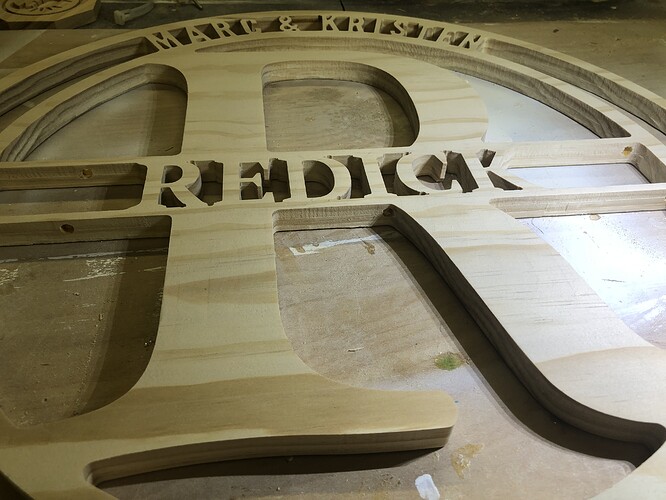Usually i try to buy stock at my desired thickness, but i decided to try and glue together stock to my desired thickness.
Just wondering if others have done this and if the stresses the tool puts on the wood cause it to come apart.
I don’t have a planer but i did a rough sand on the 2 pieces before i glued them up.
thanks
If you’re using a PVA type glue like titebond, those parts aren’t coming apart. Just make sure you let them cure for long enough, and surface if you need to so the boards have a lot of surface area in contact. I’m assuming they are both relatively flat or at least cupped together.
You’re kind of making plywood with very thick pieces, and plywood machines just fine on the shapeoko.
I used titebond II for this and glued 2 boards together. This is 20” in diameter and if you look at the 2nd picture you can see the holes where my dowels used to be. I used a 1/4” end mill to cut through this and the glue joint held strong. Dan’s right, it’s not coming apart.
It’s all about grain orientation. If you’re joining face grain to face grain with both pieces having their grain running in the same direction - with ANY wood glue - and you don’t have large voids or pockets due to uneven boards, the glue joint will be stronger than the wood itself.
End grain to end grain, or end grain to face grain, will not work properly without a spline, biscuit, or some other long grain solution inside of the joint.
Lastly, face grain to face grain will fail (eventually), if the grains are running perpendicular to each other, if the pieces are of substantive thickness…this is because wood moves a greater distance across its grain than with it…so if the grain is aligned, everything expands and contracts together, but if they’re orthogonal to each other, they will expand and contract at different rates and put stress on the joint. That will eventually cause either the joint to fail, or the wood to crack.
Plywood is made up of relatively thin layers of wood with grain running in different directions…and because they’re stacked evenly - the pressures of each layer work against each other, and cancel each other out - hence it’s dimensional stability. Just two pieces of wood will not have that same effect.
Pay attention to grain orientation - avoid butting end grain joints - and you will have no problems with normal yellow wood glue.
If you are gluing two layers together you do not need any mechanical fasteners. Mechanical fasteners do not increase strength but usually are alignment tools. If you are gluing two layers of solid wood together you need to run the grain in the same direction. Have one board the size you want and the other slightly larger. After glue is dry trim the larger board to the size of the smaller board. It is almost impossible to get two boards the exact same size to not move around when gluing and clamping. When you glue any two boards together you need to clamp them together. It does not require a gorilla grip to clamp just a firm clamping pressure and if you do not have clamps long enough to reach the middle then use a heavy object to help with glue adhesion. Just glue alone does not keep the board together rather it is the glue seeping into the grain of the joint and bonding together with the wood.
If you are edge gluing then you need perfectly jointed edges to maximize the chance of your glue sticking. A wavy edge on either board will lead to failure. When you clamp the two boards together a firm clamp is all that is required. You do not want to squeeze all the glue out of the joint. Use clamps on alternating sides of your boards to keep from bowing the boards from clamping pressure. You can use some hand clamps on the two outer edges to keep the boards in alignment. During clamp up the boards are slippery and will tent to move around. You can avoid this by lightly clamping the boards where they meet. Not too tight because you want the clamps to draw the boards together. After you get the cross clamps on then you can tighten the clamps at the junction if required.
Clamps pull the work together but do not over tighten and squeeze all the glue out. The boards must come together and touch because a joint with gaps and PVA glue will not hold together. You can use Polyurethane glue if you have gaps because that glue expands during drying and fills gaps. However the poly glue can expand your joint apart so I would not recommend poly glue for edge jointing.
This topic was automatically closed 30 days after the last reply. New replies are no longer allowed.

